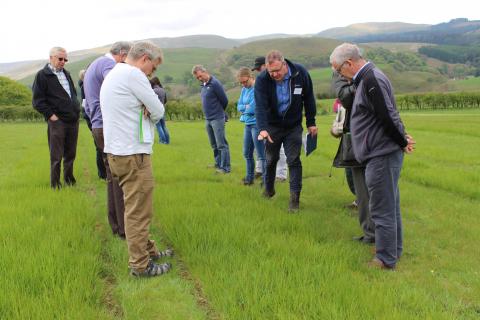The latest research projects aiming to improve sustainability in the Welsh uplands were showcased to farmers at an open day at one of Farming Connect’s new Innovation Sites.
At Pwllpeiran Upland Research Centre in Cwmystwyth, studies into upland farmed ecosystems have been carried out since the 1930s. The farm is subdivided into parcels of land for research and experiments focusing on sustainable intensification, which aims to balance productivity and biodiversity.
Building on success of unique resource
Farming Connect will be involved in building on the success of the unique Brignant long-term extensification plots, which were established more than 20 years ago to test the effectiveness of different management techniques in reverting improved permanent pasture to semi-natural vegetation. Three extra blocks will be created to test the effectiveness of treatment with a regeneration harrow and with or without slot seeding with legumes. The legumes used will include types specifically selected for their ability to establish in marginal soils and grazing tolerance.
Dr Mariecia Fraser said: “We’re going to clear out the moss and dead material from the grass and start putting on a little bit of nutrient and add in legumes. We should have something that is still environmentally friendly but also more productive.”
Attendees also heard information regarding the below funded research projects at Pwllpeiran:
Forage legumes in the uplands
Forage legumes present a source of high quality, home-grown protein, but growing them successfully in the uplands are challenging due to conditions such as shallower soil depth, acidic soils, reduced soil fertility and lower temperatures.
Plant scientist Jim Vale said: “There is a lack of quality herbage in the sward in upland areas, particularly protein, which manifests in low stocking rates and poor performance in animals.”
The trial plots of red and white clover are testing lines that have been bred specifically for efficient nutrient uptake, cold tolerance and drought resistance. A second trial is investigating the feasibility of using birdsfoot trefoil on upland farms. So far the trials have produced mixed results, but the varieties that have survived best could be bred for commercial use in the future.
Yellow Gold
Daffodils are being commercially grown at Pwllpeiran for the production of a compound that is an approved treatment for Alzheimer’s Disease. When grown in upland areas daffodils produce more of the chemical from which galantamine is extracted, possibly due to the harsher growing conditions. The project is integrating daffodils into existing upland pasture and harvesting the green growth. The swards can then be grazed and trials are evaluating the impact of the daffodils on animal performance and stock carrying capacity of the land. The six plots, measuring one hectare each, are planted in September and the daffodils harvested in April, with the bulbs left in the ground for reproduction, lasting up to four years.
Different varieties are being used to determine which produce more galanthamine and there are high hopes that optimising the balance between commercially growing daffodils and rearing stock in upland areas will offer an additional income stream for farmers.
Miscanthus as an alternative bedding source
Buying straw for bedding is a major cost for many upland livestock farmers and can also have a high environmental impact. Miscanthus is increasingly being used as an alternative bedding material and can be grown on more marginal land, with trial plots planted at Pwllpeiran in 2004 still producing over seven tonnes of dry matter per hectare each year. Trial plots of two new hybrid varieties were established in 2015 and early results show great promise as a potential source of livestock bedding on upland farms.
A new trial will test a standard miscanthus variety against a hybrid under conventional and minimum tillage establishment using novel techniques; seed planting under biodegradable mulch films.
Naturally cleaning waste water
Farmers were also shown the Integrated Constructed Wetlands, a series of five ponds which capture nutrients in their plants and sediments, preventing run-off from farms from affecting local catchments.
Scientist Mike Williams said: “It’s a way of cleaning water but it also encourages the biodiversity of plants, invertebrates and birds that feed and nest here.”

